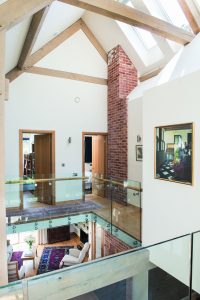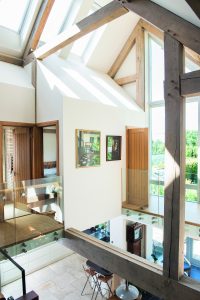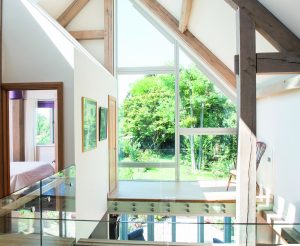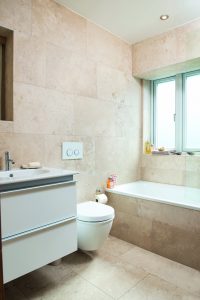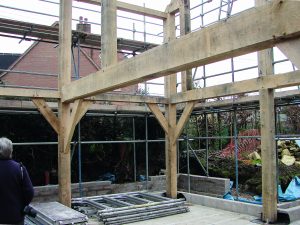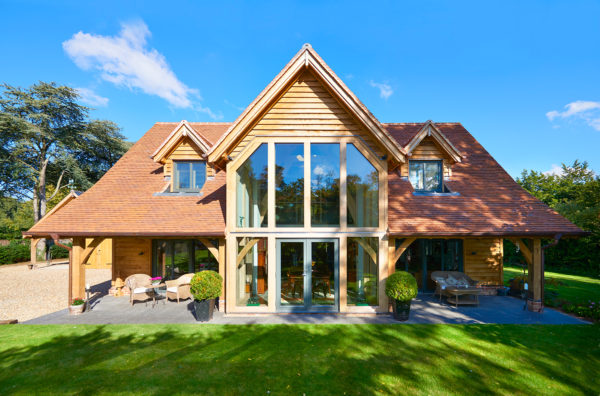Bright and Contemporary Oak Frame Home
After more than four decades living in Bristol, and with retirement approaching, John and Ann Sterry fancied a change. The couple were keen to up sticks and move to a leafy part of Worcestershire – but finding a suitable new home posed something of a challenge.
“Our previous house was 300 years old and suffered with all the issues you might associate with a building of that age,” says John, who was keen for their next property to be problem-free. “We looked at various places across the Midlands, but all of them had issues that put us off.”
The Perfect Self Build Plot
The couple realised the only way they could get what they wanted in their chosen area was to build from scratch. But finding the perfect rural plot wasn’t without its challenges. The pair had four key criteria for their new home’s location.
“It needed to be near hills, trees and water, whilst being safe for cats,” says Ann. “We’re used to walking from the house into the open countryside and wanted the same opportunities. Initially, we looked around the outskirts of small towns – but the sites all felt too urban.
“After an exhaustive search using services such as BuildStore’s online land resource, PlotSearch, the couple eventually found something that would fit the bill – although there was one significant compromise to be made. “It was smaller than we’d originally envisaged, which impacted on the size of the house and garden, but the location was the most important factor,” says Ann.
With a plot in the bag, designing the right house became something of a family affair. The couple’s architect son Robert, who works for London-based practice Paul Archer Design, was appointed to take the scheme forward.
“Robert’s ideas were initially inspired by our interest in timber frame buildings,” says Ann. “He came up with a number of outline designs for us, which we gradually modified until we had what we wanted.”
- NamesJohn & Ann Sterry
- LocationWorcestershire
- ProjectSelf-build
- StyleContemporary
- Construction methodOak frame & structural insulated panels (SIPs)
- Plot cost£185,000
- House size130m2
- Build cost£446,056
- Total cost£631,056
- Build cost per m2£3,431
- Construction Time48 weeks
Design Ideas
The Sterrys were keen to open up the main living area to the roof, even though it meant they would have to reduce bedroom sizes. “As we spend most of our day in that main, large space, it seemed a good decision,” says John. “We wanted a lighter environment than our previous house, while retaining similar finishes such as the use of oak and stone flooring.”
They were also keen to integrate new technology and make use of sustainable energy sources. The key aim, however, was to build an oak frame house that would encompass their goals without ending up being a pastiche of the traditional black-and-white cottage.
Innovation was the order of the day, so the couple visited Carpenter Oak’s headquarters in Totnes to discuss their early-stage ideas.
“The team worked with Robert to produce a frame that matched up to our hopes,” says John. “They understood what we were trying to build from the beginning and maintained good communication throughout the manufacture and erection of the structure. The oak frame is integral to the house design and gives it real character by displaying traditional shapes and materials in a modern setting, which is what we wanted.”
Planning Maze
Securing planning consent was trickier than expected, taking 12 months in total. The original design gave rise to concerns among both the parish council and some neighbours, so it had to be modified and resubmitted. It turned out that the Village Plan stipulated a number of restrictions to do with roof pitches, window sizes, exterior cladding and even the position of gable walls, which had to face the road.
The couple finally secured consent after hiring a local planning consultant who had a fuller understanding of the planning guidance, which intends to ensure all new dwellings preserve or enhance the historic and architectural interest of the parish.
“The settlement features a mix of building materials, including brick, vernacular stone, exposed timber frames, slate and clay tiles, and thatch,” says Ann. “But the planners wanted the house to have a Cotswolds appearance – even though we’re not in the Cotswolds! We’re in a conservation area and an area of outstanding natural beauty, so perhaps this informed their prescriptive approach to the design.”
In the frame
When the couple started out, they set an initial budget of £200,000 for the plot and £300,000 for the build – although they suspected that costs would rise as they went through the process. As they continued to work throughout the project, the lion’s share of this was met from their income and by dipping into savings.
Finding the right builder was made easier thanks to a neighbour, who recommended a local contractor, Chris Washbourne. After checking examples of his work, John and Ann decided to go ahead – and Chris then employed his own team to tackle the project.
Craning the oak structure into place turned out to be relatively straightforward. “It went up in less than two-and-a-half days,” says John. The smooth process was aided by sending pictures of the site and access details, to ensure the delivery lorries could get through.
The frame itself was a two-storey, three-bay construction. “It was unusual in that it didn’t have tie beams at eaves level, but instead had very high collars in the roof spaces,” says Paul Slemmings, frame designer at Carpenter Oak.
“The span and truss arrangement required the central floor beams to be 350mm deep in order to withstand the loads. The straight bracing, rather than curved, creates a contemporary feel – but it still features traditional joints.”
With the oak skeleton in place, the SIPs wraparound was delivered and went up in about three-and-a-half days. Just two weeks after the frame had arrived, the window apertures were sealed with thick transparent polythene, which meant that the inside of the house was fundamentally waterproof.
Heating the House
Achieving good energy efficiency was a key consideration in every aspect of the build. Although double-glazing was initially suggested, John and Ann opted for triple panes after spending time researching the market. “We did this in an attempt to future-proof the house as much as possible,” explains John, who also feels the SIPs wraparound gives high levels of insulation and airtightness.
The house is warmed with underfloor heating, fuelled via a Vaillant ecoTEC boiler connected to a Megaflow pressurised water system and tank. Thanks to the open-plan ground floor’s vaulted ceiling, heat rises into the first floor rooms – so the radiators in the upstairs bedrooms are rarely needed.
In an attempt to be as self-sufficient as possible, the Sterrys wanted to minimise their use of utilities. A Vent-Axia mechanical ventilation and heat recovery (MVHR) system captures warmth from stale air and redistributes it throughout the house as part of a fresh supply. “We can switch the heat recovery part off in summer,” says Ann.
The couple are both pleased with the solar thermal panels on the south-facing roof, which supplies all the hot water they need in summer, except on cloudy days. In hindsight, though, John and Ann admit that had they conducted more research, they would have added solar photovoltaic panels because the MVHR system uses a fair amount of electricity.
Another trick to reduce the couple’s reliance on conventional utilities was to install a 3,000L underground rainwater tank, filled from the roof’s downpipes. The water is subsequently filtered and used for flushing toilets and in the washing machine, which automatically switches to mains water when the tank is empty.
Taking Stock
Reflecting on the overall project, John and Ann are very satisfied with the high standard of workmanship – particularly the precise alignment of the large gable windows and construction of the staircase. If they were starting again, however, they admit there are some things they would do differently.
“We’d try to incorporate more storage space, although the size of this plot and therefore the house didn’t allow for further expansion,” says John. “An external means of shading the west-facing window from intense sunlight, such as a slatted screen or overhanging roofline, would have been beneficial, too.”
Nevertheless, overall, the couple are delighted with their new home. “The satisfaction of seeing it grow and develop into the property we wanted was wonderful,” says Ann. “The end result is a very pleasant house located in a friendly and welcoming community.”
The delays they faced during parts of the work haven’t put them off self-building in the future – in fact they would jump at the chance. “We’d be interested in creating a more conventional house to let out; if it was for our own use, we’d probably just repeat the exercise pretty much as before,” says John.
| The Sterrys’ home was one of six nominated for Best Self-Build or Renovation Project in the Build It Awards 2017. To see the other contenders click here |

































































































 Login/register to save Article for later
Login/register to save Article for later





